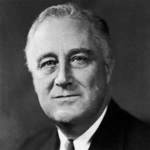
When Babu read the passage about FDR’s birthday being celebrated with 6,000 parties I wondered out loud: “Why?” She asked about what his reaction to that was in her journal and she talked about the fact that a record of his reaction must actually exist. She was right. Ok, Babu. I get the point. I went into research mode and, of course, Babu was right. (It was 600 birthday parties “in his honor,” not 6,000, but who can blame her for youthful exaggeration?)
From the website:
Birthday Balls:
Franklin D. Roosevelt and the March of Dimes
“In sending a dime,…and in dancing that others may walk, we the people are striking a powerful blow in defense of American freedom and human decency.” Franklin D. Roosevelt
January 30, 1940
“It is glorious to have one’s birthday associated with a work like this. One touch of nature makes the whole world kin. And that kinship, which human suffering evokes, is perhaps the closest of all, for we know that those who work to help the suffering find true spiritual fellowship in that labor of love.” Franklin D. Roosevelt
Radio Address for the Fifth Birthday Ball
January 30, 1940When the President of the United States celebrates his birthday, it is rare for the day to have significance for anyone outside the select few invited to the party. However, when Franklin D. Roosevelt celebrated his birthday, Americans all over the nation participated, and even more people benefited, because FDR used his birthday to advance his most important cause – the fight to find a cure for infantile paralysis. January 30th was no longer just his birthday, but a day dedicated to raising money for polio research and treatment.
Ever since he contracted polio at the age of 39 in 1921, Franklin Roosevelt actively sought new treatment to improve his life, as well as the lives of all persons afflicted with infantile paralysis, donating as much money as he could and encouraging others to do the same. In 1924, Roosevelt’s quest led him to Warm Springs, Georgia, where other polio patients experienced relief in the buoyant mineral water of Warm Springs. Confident that his six weeks in the waters of Warm Springs did more to improve his condition than any treatment he had received in the previous 3 years, FDR made a home for himself in Georgia, and invited other patients to join him. His presence, money, and prestige helped to make Warm Springs a world-class facility for the treatment of infantile paralysis.
When Warm Springs, a former resort area, faced economic hardship in 1926, Franklin Roosevelt purchased the facility for $200,000 and created a therapeutic center under the direction of the Georgia Warm Springs Foundation, later named the Roosevelt Warm Springs Institute for Rehabilitation. The Warm Springs Institute opened its doors to patients all over the country, providing medical treatment and an opportunity to spend time with others suffering from the effects of polio.
Unfortunately, the facility in Warm Springs needed more than just Franklin Roosevelt’s money to treat its growing number of patients, and he started asking friends for monetary contributions. Initially, Roosevelt’s fund-raising campaign was a small-scale operation, but that changed when his associate Keith Morgan called upon business magnate Henry L. Doherty for a donation. Hoping to improve Doherty’s public image and win him political favor with FDR, Carl Byoir, Doherty’s public relations consultant, suggested that Henry Doherty sponsor a dance in every town across the country to celebrate the President’s birthday and raise money for Warm Springs. With a $25,000 contribution, Doherty launched the National Committee for Birthday Balls. Although Doherty did not receive special political favor with FDR, Birthday Balls became an annual fundraising success.
The first Birthday Ball was held in 1934; 4,376 communities joined together in 600 separate celebrations to raise over one million dollars for the Warm Springs Foundation. Future fundraising contributions were split between Warm Springs and the local communities in which the Birthday Balls were held.

I shared this with her and she showed a lot of interest. She didn’t remember how FDR had suffered from Polio. She read aloud from the website that began with FDR’s reactions.
So, over 80 years later, thanks to modern internet researching, I was able to give babu what she asked for.
You might find the Ken Burns series “The Roosevelts” very interesting. So might Babu. It is so very well done and your local library may have it on DVD–if you haven’t already watched it.
LikeLike
Oh thanks maybe it’s on the web!
LikeLike